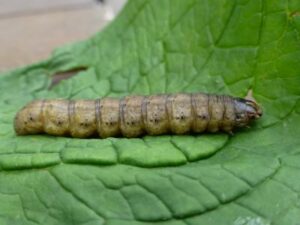By: Louis Sutton, Regional Product Manager (West); Agronomy Lead
There have been some reports of black cutworms already affecting corn and soybean fields this year. So you need to monitor your fields and spray for this pest if you have any issues.
Black cutworm larvae can feed on several broadleaf and grass crops, but the main crop they feed on is corn. Young larvae create irregular holes in corn leaves or may cut into small weeds. Young larvae feeding normally does not cause many issues but can be a good indicator of issues to come. Larger larvae may feed on stems below the soil surface, which can cause plants to wilt and die. However, the typical injury seen by large black cutworm larvae is cutting plants, and a single larva may cut many corn plants during its lifetime. The fourth and fifth instar are the stages the cutworm causes the most damage and they pupae after the fifth instar. After V5 stage in corn, cutworms are not an issue until they feed on the tassel or ear.
Scouting fields every 7-to-10 days until corn reaches V5 is recommended. Rescue treatments tend to be the most economical approach, but occasionally preventative insecticide treatments are needed. The unique insecticide package in AgVenture’s Security Seed Protection System™, powered by LumiGEN®, features broad spectrum protection against early season insects, including cutworm, white grub, and seed corn maggot, among others. Consult your AgVenture Yield Specialist and others in your circle of influence to determine the best course of action for your specific operation.
In soybeans, the main concern with black cutworm is when they feed on the pods later in the season. Cutworms can and do cut bean plants, but soybeans can usually compensate for a few lost plants. However, if heavy feeding occurs then a treatment may be needed.
Black cutworms can also be found in grain sorghum. In sorghum, they cut plants and reduce stands and feed on the heads later.
If you find black cutworms in any of your fields, consult your AgVenture Yield Specialist to determine the best course of action for your operation.

